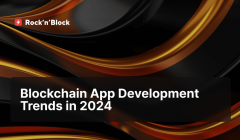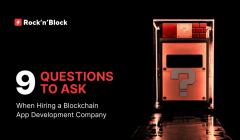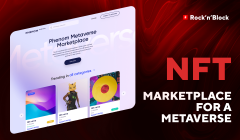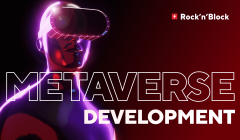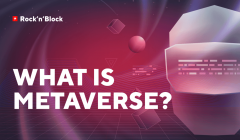How-To Guide On Metaverse App Development
03 May 2024The Metaverse is a digital realm that offers immersive experiences beyond physical reality. In this guide we focus on Metaverse app development to identify the essential components that drive the creation of these environments. Our recent article uncovered Metaverse software development, including its use cases and the importance of proficient Metaverse development companies for success in this ecosystem. Now, we will delve deeper into Metaverse app development, discussing the required technologies, key features, and strategic process for creating compelling experiences.

Metaverse App Development Use Cases
In the expansive universe of Metaverse app development, innovation knows no bounds. As developers and businesses continue to explore this landscape, it's essential to recognize the diverse use cases for Metaverse applications that shape our digital experiences. Let’s delve into different Metaverse app development use cases, expanding your understanding of the multifaceted opportunities that this burgeoning ecosystem offers.
Social and Networking Platforms Development
Social and networking platforms represent one of the most common use cases of Metaverse apps. They foster connections and interactions within virtual communities. These platforms enable users to create personalized avatars, engage in real-time communication, and participate in shared activities and events. From virtual hangouts and immersive chatrooms to collaborative workspaces and virtual conferences, social and networking platforms redefine the way we connect and collaborate in the digital realm.
E-commerce and Virtual Marketplaces App Development
E-commerce and virtual marketplaces are gaining more and more attention nowadays. This Metaverse app development use case offers innovative solutions for buying, selling, and exploring virtual goods and services. These platforms enable users to browse virtual stores, purchase digital assets, and engage in virtual commerce transactions within immersive digital environments. From virtual fashion shows to digital fitting rooms, e-commerce and virtual marketplaces create new avenues for monetization and consumer engagement within the Metaverse.
Educational and Training Simulations
Modern learners demand engaging and effective educational experiences, which traditional methods often struggle to deliver. Metaverse app development can offer a solution to this challenge by developing educational and training simulations. By immersing learners in interactive virtual environments, these simulations bridge the gap between theory and practice, foster collaboration, and personalize learning experiences. Through adaptive technologies and collaborative tools, users engage in hands-on activities, gaining practical skills and knowledge essential for success in the digital age.
Health and Wellness Experiences
Health and wellness experiences emerge as a growing use case for Metaverse app development, offering innovative solutions for promoting physical and mental well-being within virtual environments. Metaverse app development can include functions such as fitness tracking, mindfulness exercises, and virtual coaching to support users in achieving their health and wellness goals. From virtual fitness classes and guided meditation sessions to immersive relaxation environments and mental health support groups, health and wellness experiences provide users with tools and resources to prioritize self-care and holistic well-being within the Metaverse.
Virtual Real Estate and Asset Marketplaces
Virtual real estate and asset marketplaces represent a burgeoning category within Metaverse app development, offering users the opportunity to trade virtual properties, assets, and collectibles. These platforms provide a marketplace for digital assets, including virtual land, buildings, and other virtual items, allowing users to invest in virtual properties and participate in virtual economies. From virtual land auctions and digital art galleries to decentralized Metaverse NFT marketplaces, virtual real estate and asset marketplaces enable users to explore new avenues of ownership and investment.
Technology Stack for Metaverse App Development
Understanding the essential components of the technology stack is crucial for building robust and engaging Metaverse applications. In this section, we will delve into the key technologies required for Metaverse app development, shedding light on the foundational elements that power these immersive digital experiences.
Blockchain and Decentralized Technologies
Blockchain and decentralized technologies are essential components of Metaverse app development, enabling secure transactions, ownership rights, and digital asset management within virtual environments. Let's explore how blockchain technology forms an integral part of the technology stack for Metaverse app development:
-
Blockchain Platforms
Blockchain platforms provide decentralized infrastructure and smart contract capabilities for Metaverse app development. Leveraging blockchain platforms like Ethereum, BNB Chain, Polygon, Polkadot or Solana, developers can create smart contracts, enabling the integration of features such as digital ownership, secure transactions, and decentralized identity within virtual environments.
-
Smart Contracts Development
Smart contracts are self-executing contracts with the specific terms written in code. Within the Metaverse, smart contracts facilitate automated transactions, enforce digital ownership rights, and enable complex interactions between users and virtual assets. Key tools and languages for smart contract development include:
Solidity: Solidity is a high-level programming language specifically designed for writing smart contracts on the Ethereum blockchain. Its syntax is similar to that of JavaScript, making it accessible to developers familiar with web development.
Rust: Rust is gaining traction as a language for smart contract development, particularly in the context of blockchain platforms like Polkadot and Solana. Known for its performance, safety, and concurrency features, Rust offers developers a robust toolset for building secure and efficient smart contracts within the Metaverse.
-
Immutable Data Storage and Verification
Blockchain technology offers immutable data storage solutions, ensuring that content within Metaverse applications remains tamper-proof and verifiable. InterPlanetary File System (IPFS), a decentralized storage network, allows developers to store data across a distributed network of nodes, enhancing reliability and resilience. By leveraging IPFS, developers can ensure that assets such as 3D models, textures, or media files remain accessible and verifiable within the Metaverse.
-
Secure Transactions and Micropayments
Blockchain technology enables secure and transparent transactions within Metaverse applications, facilitating peer-to-peer payments, microtransactions, and digital commerce. Cryptocurrencies and blockchain-based payment systems provide fast, secure, and low-cost transaction options, eliminating the need for intermediaries and reducing transaction fees. By integrating blockchain-based payment solutions, Metaverse app developers can create seamless and frictionless monetization opportunities.
-
Interoperability between Metaverse Platforms
Blockchain technology promotes interoperability and cross-platform compatibility within the Metaverse, enabling seamless integration between different virtual environments and applications. Blockchain development companies usually create solutions that allow collaboration and interoperability between many blockchain-based projects, ensuring that users can transfer assets and identities across different platforms and ecosystems. Cross-chain communication protocols like Cosmos Inter-Blockchain Communication (IBC) further facilitate interoperability, enabling secure and trustless asset transfers between different Metaverse platforms.
Graphics Rendering Engines
At the heart of Metaverse app development lies the graphics rendering engine, responsible for generating immersive virtual environments and rendering realistic 3D graphics. These engines leverage advanced rendering techniques such as ray tracing and shader programming to create lifelike visuals that captivate users. Whether it's rendering intricate landscapes, simulating realistic lighting effects, or animating dynamic characters, a powerful graphics rendering engine forms the backbone of any Metaverse application, delivering immersive experiences that blur the lines between reality and virtuality.
Among the leading options in this domain are Unreal Engine and Unity, renowned for their robust capabilities in rendering high-fidelity graphics, immersive 3D environments, and realistic physics simulations. Unreal Engine is known for its photorealistic rendering capabilities and advanced visual effects, making it a popular choice for AAA game development and immersive experiences within the Metaverse. Meanwhile, Unity is versatile and accessible, empowering developers to create cross-platform experiences with ease. Leveraging graphics rendering engines like Unreal Engine and Unity is essential for a Metaverse app development, regardless of whether you prioritize cutting-edge visuals or seamless cross-platform compatibility.
Essential Features of Metaverse Applications
In the dynamic realm of Metaverse app development, crafting compelling digital experiences requires a strategic blend of creativity, innovation, and user-centric design. As businesses and developers venture into this immersive landscape, understanding the essential features that define successful metaverse applications is paramount. In this article, we'll explore key features that play a pivotal role in shaping the user experience and driving engagement within metaverse applications.
Immersive Virtual Environments
At the core of Metaverse app development lies the creation of immersive virtual environments that captivate users' senses and transport them to new realms of digital exploration. These environments leverage advanced graphics rendering, spatial audio, and interactive elements to create lifelike and engaging experiences. Whether it's exploring virtual landscapes, interacting with virtual objects, or engaging in social activities within shared spaces, immersive environments form the foundation of compelling metaverse applications.
Real-Time Interaction
Real-time interaction is a crucial aspect of metaverse applications. It allows users to engage with virtual environments and other users in meaningful ways, fostering collaboration, socialization, and shared experiences within the Metaverse. Real-time communication can take many forms, including voice chat, text messaging, or gesture-based interactions.
Custom NFT Avatars and Personalization
Custom NFT avatars and personalization features empower users to express themselves and create unique identities within the metaverse. From customizable NFT avatar development and virtual wardrobes to personalized profiles and virtual homes, these features allow users to tailor their digital presence to reflect their individual preferences and personalities.
In-App Economy and Transactions
In-app economy development and transaction features enable users to trade virtual goods and services within metaverse applications. From virtual currencies and digital assets to virtual marketplaces and in-app purchases, these features facilitate economic transactions and monetization opportunities within virtual environments. By creating a thriving virtual economy, in-app economy and transaction features drive user engagement and enable new revenue streams within metaverse applications.
Decentralized Identity and Authentication
Decentralized identity solutions offer a secure and privacy-enhancing way to manage user identities within metaverse applications. By leveraging decentralized identity protocols like Decentralized Identifier (DID) or Self-Sovereign Identity (SSI), Metaverse app developers can enable users to maintain control over their identity information and authenticate themselves across different virtual environments.
Multiplayer
Peer-to-peer (P2P) networking forms the backbone of communication and interaction within metaverse applications, enabling real-time collaboration and socialization between users. P2P networking protocols like WebRTC or libp2p facilitate direct communication between users' devices, reducing latency and enabling seamless interactions within virtual environments. By leveraging P2P networking, Metaverse app developers can create scalable and resilient Metaverse applications that support large numbers of concurrent users and foster rich social interactions.
Metaverse App Development Process
In this part we will navigate you through the key stages of the Metaverse app development process.
Step 1. Defining Goals and Market Research
The journey into Metaverse app development starts with a deep dive into defining your objectives and conducting comprehensive market research. Determine why you need a Metaverse app — whether it's to enhance customer engagement, create immersive training simulations, or explore new revenue streams. Understand what type of app you want to create. Identify your target audience and analyze their demographics, preferences, and behaviors to tailor your app to their needs and expectations. This step provides valuable insights, laying the groundwork for informed decision-making.
Step 2. Choosing the Right Metaverse App Development Company
Choosing the right Metaverse app development company is pivotal in realizing your Metaverse vision. Look for a reputable Metaverse app development company with a proven track record of success and expertise in relevant technologies. Consider factors such as industry experience, technical capabilities, and client testimonials when evaluating potential partners. Collaborate with a company that shares your vision, understands your goals, and possesses the skills and resources to bring your ideas to life.
Step 3. Discussing the Project with the Development Company
Once you've identified the right development company, initiate discussions to outline the project scope, requirements, and timeline. Schedule meetings or workshops to brainstorm ideas, clarify objectives, and define key features and functionalities for your Metaverse app development. A blockchain development company can also assist you in choosing a blockchain platform that aligns with your project's requirements and goals.
Step 4. Design and Prototyping
With project discussions underway, the focus shifts to design and prototyping. Designers are working to create wireframes, mockups, and visual concepts that bring your Metaverse app to life. Prototype development allows for early validation of design concepts, usability testing, and iteration based on feedback. A development company pays close attention to user experience (UX) and user interface (UI). Capturing users' attention in today's competitive landscape is a challenging task, making the role of compelling UX/UI design in Metaverse app development even more critical. Designers enhance user experience and foster engagement and connections within the Metaverse through intuitive navigation, personalized avatars, seamless interactions.
Step 5. Development Phase
Once the design is finalized, developers move on to the development and implementation phase of your Metaverse app. They use cutting-edge technologies to build the foundational infrastructure, integrate features and functionalities and create immersive virtual environments. They also create smart contracts using blockchain technology to enable decentralized transactions, digital asset management, and transparent governance mechanisms, ensuring a robust and secure Metaverse experience.
Step 6. Testing and Quality Assurance
Testing and quality assurance are critical steps in ensuring the reliability, performance, and usability of your Metaverse app. Metaverse development company conduct comprehensive tests across various devices, platforms, and scenarios to identify and address any bugs, glitches, or usability issues.
Step 7. Deployment Phase
With rigorous testing complete, your Metaverse app is ready for deployment and distribution to the intended audience. This involves deploying the final version of an app onto the mainnet, ensuring that it is accessible to users worldwide. Choose right distribution channels, whether through app stores or web platforms to reach your target audience effectively. Implement app analytics and monitoring tools to track performance metrics, user engagement, and feedback post-deployment, enabling continuous improvement and optimization.
Step 8. Continuous Improvement and Updates
The journey of Metaverse app development doesn't end with deployment, rather, it marks the beginning of an ongoing process of refinement and enhancement. Monitor user feedback, analyze market trends, and leverage data insights to prioritize future updates and improvements. Iterate on features, introduce new functionalities, and adapt to evolving user needs and technological advancements to ensure that your Metaverse app remains competitive and relevant in the ever-changing digital landscape.
Conclusion
Navigating the realm of Metaverse app development requires a strategic blend of innovation, technology, and foresight. From conceptualization to mainnet deployment, each step in the journey is significant in shaping the future of digital interaction and immersive experiences within virtual environments. Developers can unlock boundless possibilities and usher in a new era of connectivity, creativity, and community within the Metaverse by embracing cutting-edge technologies such as blockchain, augmented reality, and artificial intelligence. The Metaverse presents a frontier full of opportunities for those who are innovative and creative. With the right expertise, vision, and execution, it has the potential to transform how we live, work, and play in the digital age.
We ❤️ Development
Follow us on social media to receive the hottest blockchain development updates
Twitter ⚡️Telegram⚡️LinkedIn⚡️Facebook

